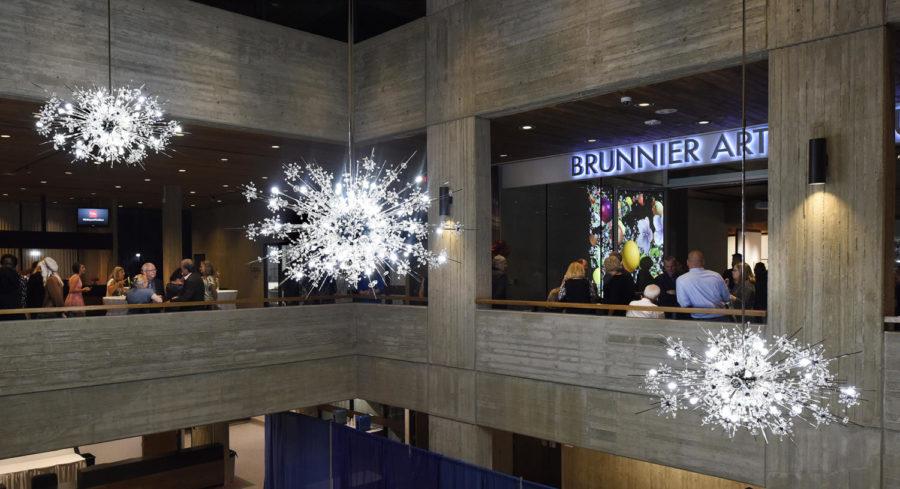Chief curator of University Museums discusses campus art
“Met Chandelier,” designed by Hans Harald Rath in 1963-1966 and manufactured by Lobmeyr-Werkstätten in 2019. The art piece is part of the Art on Campus Collection of University Museums at Iowa State.
November 21, 2019
Iowa State has the largest public campus art collection in the United States.
Works of art can be seen around campus in five areas: Christian Petersen Art Museum in Morrill Hall, Farm House Museum, Anderson Sculpture Garden, Brunnier Art Museum in the Scheman Building and the Art on Campus Collection.
Some famous works of art at Iowa State include Grant Wood Murals at Parks Library, Fountain of the Four Seasons outside the Memorial Union and the Gentle Doctor sculpture at the College of Veterinary Medicine.
Lynette Pohlman, director and chief curator of University Museums, has worked at Iowa State for 48 years. Pohlman started at Iowa State in April of 1971 with the restoration of Farm House Museum for the United States Bicentennial in 1976.
“Iowa State was undertaking [the Farm House Museum restoration] as a preservation project and that then led to the arrival of the Brunnier Art Collection in two semi trucks,” Pohlman said. “I helped unpack that and then open the […] Henry J. Brunnier Art Gallery in 1975 and became director in 1980.”
Throughout Pohlman’s time at Iowa State, the three other art units were established: Art on Campus Collection in 1983, Christian Petersen Art Museum in 2007 and Anderson Sculpture Garden in 2007.
“We are the University of Museum’s umbrella as an administrative unit,” Pohlman said. “That provides huge efficiencies for Iowa State. If you go to other potential academic institutions, you would have a staff for each one of those.”
Pohlman said each of the five campus units has its own philosophy that determines the theme for the works displayed. For example, Farm House Museum, Iowa State’s oldest building, primarily features works from approximately 1860 to 1910 that relate to Iowa State and life in Iowa during that time period.
The works of Susan Chrysler White are currently featured at The Christian Petersen Art Museum. Iowa State has recently acquired White’s art for public viewing at The Hub and The Friley Dining Facility.
“The purpose of always trying to do an exhibition by a public artist that we’ve commissioned is to show the campus a larger array of […] the body of work by that artist,” Pohlman said. “It’s kind of like reading the same author and getting their perspective and their viewpoint of life and their expression.”
Pohlman said art can be acquired for the university in a number of ways, such as through a commission, purchase, gift or transfer from another museum.
Pohlman said when considering a work of art they look at how it meets the strengths of the collection. The process was used recently in the renovation of the Brunnier Art Museum in the Scheman Building.
“When we did the renovation, I wanted to be sensitive, complementary and respectful to that mid-century design,” Pohlman said.
On public display outside the Brunnier Art Museum is three Lobmeyr chandeliers, which Pohlman said were chosen due to their mid-century style from 1963 and as an addition to Brunnier’s renowned glass collection.
Pohlman said only the Brunnier Art Museum and The New York Metropolitan Opera has that style of Lobmeyr chandeliers on display.
“They are an iconic image of mid-century expression, in that case international expression,” Pohlman said. “It’s time-appropriate, it’s style-appropriate and it makes a statement. […] It says ‘you have arrived at an artful place.’”
In Iowa State’s museum collections, Pohlman said usually a curator takes a work to an acquisition committee to validate the work’s purchase and the art then becomes part of the public trust, while public art purchases at Iowa State include more collaboration with other departments on campus.
A representative or partner will appoint a committee to represent the department or college’s mission, said Pohlman.
The department can then write a public art statement describing in abstract their philosophy for public art, decide how artists are selected, oversee a budget and integrate the art into the curriculum.
Art on campus is used as a tool to teach students visual learning. Pohlman said 80 percent of what sighted people learn in life is through visual interpretation and learning, but most people do not spend time practicing visual interpretation in schools as often as things like language literacy or mathematical literacy.
“In our contemporary world most people look at a work of art for less than eight seconds and decide whether they like it or not and are dismissive of it thereafter,” Pohlman said.
Pohlman said visual learning happens everywhere and is vital to critical thinking skills. The process of describing, interpreting and evaluating visual stimuli is a critical thinking tool used everywhere that can be practiced and honed through observing art.
Evaluation leads to something more than just preference on a work of art — it leads to understanding a work of art.
Pohlman said the reason the university’s art program exists is not simply to acquire a collection, but to help students practice visual learning and interpretation.
“We have the capacity to be visually literate then improve our communication and our critical thinking skills if you practice it a little bit,” Pohlman said. “The work of art will talk to you […] you just have to be curious enough to engage in the conversation.”







